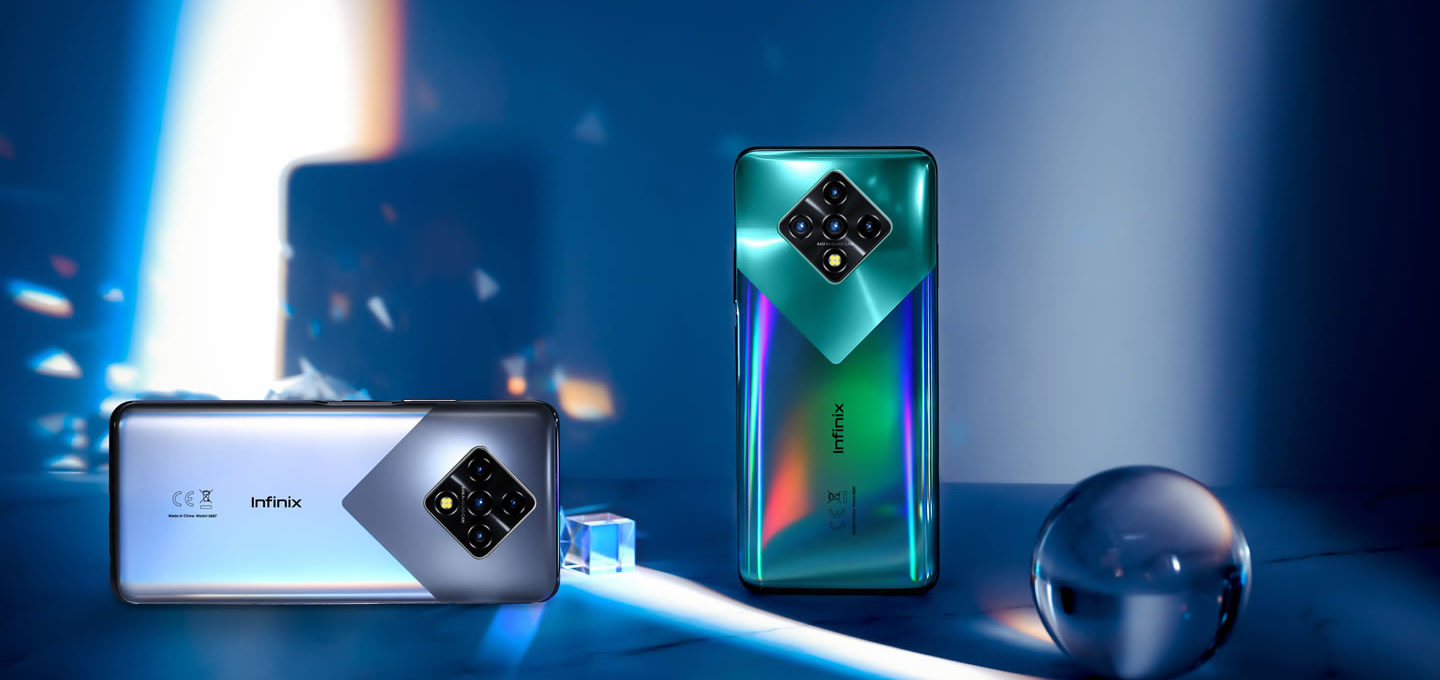The name Infinix may not be familiar to most people in the UK, but elsewhere in the world the Shenzhen-based smartphone manufacturer already commands significant market share and its fair share of fans. So when the firm asked if I would review their latest top-of-the-line device I was keen to put it to the test and see how it compares to the wealth of mid-priced handsets from the likes of Xiaomi and RealMe, which have been making waves by offering serious bang for your buck.
Out of the box the Infinix Zero 8 looks like most 2020 smartphones from the front with a big display and a double hole-punch camera in the top left. We are thankfully past the days of the huge notch (hello Pixel 3 XL), and I find the pin-holes a good option until manufacturers perfect the under display cameras.
The back of the device is something more original. There is a diamond block at the top that houses four different camera lenses and flash, with the diamond shape echoed in a triangle below where the matte silver of the top of the rear changes into a shinier silver plastic. It’s not a subtle back of the device, but instead of trying to hide the serious camera tech they have hidden in the device, Infinix have gone all out to make people notice it.
Specifications
The Infinix Zero 8 comes packing some decent specs, especially for a price that comes in at under £200, but when compared to similar priced offerings from Xiaomi and RealMe, the specs are not a huge surprise except for the screen refresh rate and the camera, which is way better that we should get for such a low price.
- Android 10 with their own XOS 7.0 skin
- 6.85″ full HD+ (1080x2460px) with 90Hz refresh rate and 180Hz touch sampling rate
- Octa-core MediaTek Helio G90T SoC
- 8 GB RAM
- 128 GB internal storage
- 4,500 mAh battery with support for 33 W fast charging via USB-C
- Measures 168.7×76.1×9.1mm
- Weighs 205g
- Multi-dimensional liquid cooling
- Fingerprint scanner (side-mounted)
- Face unlock
- Rear cameras – 64 megapixel primary sensor,= and a 8 megapixel secondary sensor, both with ultra-wide-angle lens, depth sensor, and ultra-night video, and two extra 2MP cameras.
- Front (selfie) camera – 48 megapixel primary sensor with 8 megapixel secondary sensor
Setup
Android has come on leaps and bounds in recent versions, with setup now as simple as putting in your SIM card, choosing to setup from new or import from another Android phone or an iPhone, and setting up security.
The Zero 8 is as easy to set up as most other Android devices these days, with the only oddity that I could not select the UK as a country and could only choose English (US). This is to be expected as the phone is not currently on sale directly in the UK market and will change if/when Infinix launches in the UK, but it was a bit of a surprise.
The Zero 8 runs on Android 10 with Infinix’s own XOS 7 skin, with the changes pretty minimal during setup apart from the addition of an optional sign up to the company’s own XClub social network, which they say offers chances to win prizes and more, although I did not investigate further.
In use
The first surprise for me when using the Zero 8 was that I could set up both face unlock and fingerprint unlock. Having the speed and low light option of fingerprint as well as the ease of face unlock together is the best of both worlds – other manufacturers please take note!
Beyond that, the device is mostly as you would expect to use from such a competitive device. The octocore CPU and 8GB RAM is plenty to browse the web, check Twitter, and play some games without breaking a sweat, and the 90Hz refresh rate display makes scrolling buttery smooth. I’m not a big gamer, so the device is more than powerful enough for my needs and I found no slow downs or stutters at any time while testing the device. The 128GB of RAM is also pretty generous, and should be the new normal so another tick for Infinix there.
Bundled software
The one downside for me about the Zero 8 is the bundled bloatware. My personal phone is a Pixel because I appreciate the pure Android experience with as few addons as possible. Infinix’s XOS skin looks perfectly good, with not too many changes from stock Android, but the manufacturer has kept its costs so low by including various bits of bloatware on the phone that I would just prefer was not installed.
The phone comes bundled with Ha Games, Instant Apps, the aforementioned XClub, Phone Master and various other apps that some people may want, but not me. Instant Apps is also continually being advertised in the app drawer, which is something I’d be keen to avoid. And you cannot uninstall all of them either. Xiaomi and others also install various bits of bloat to keep prices down, but I would much prefer to spend an extra £25-£50 and get a bloat-free phone – Infinix please make this happen!
Camera
In general, the Zero 8 is a good mid-range phone for a budget price, but where it really shines is the camera. Infinix has gone out of its way to offer a camera module that competes not with other mid-range handsets, but with flagships double the price.
The camera has a wealth of different modes to make sure you get the best possible shot whether you are looking to take a macro shot of a flower close-up or a bokeh-styled image that blurs the background – all are available with an AI mode to boot when you just want to snap away.
The camera modes are
- AI Cam
- Beauty
- Bokeh
- Super Night
- AR Shot
- Slow Motion
- Profession
- Panorama
- Documents
- Super Macro
- Short Video
- Video
The pictures the phones produces are far better than I had hoped for when testing the device, and whilst I do think the Pixel 5 and iPhone 11 do produce slightly better images, they retail for triple the cost. The below shot was taken in Bokeh mode:

Should you buy it?
If you are looking for a budget-priced phone that does all you need and with a very good camera and a nice large display then the Zero 8 could be a good option. If Infinix offered a version without the bundled software then I would recommend the device whole-heartedly, but even with the bloat it is a good device for the money.
Buy
Price at time of review: ₹14999 (around £175 in India)





